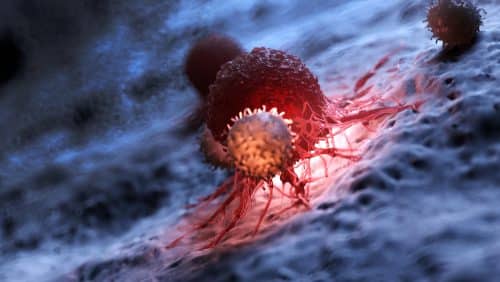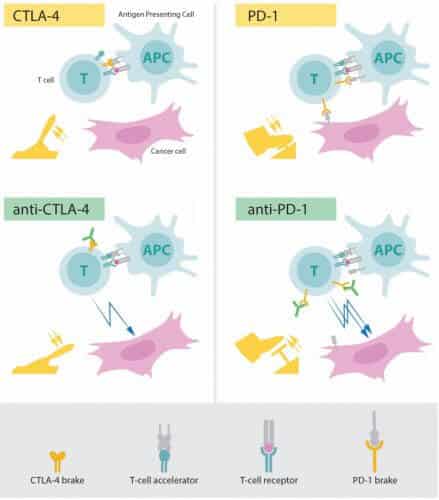Researchers Alison and Honjo showed how different strategies to disrupt the brakes of the immune system can be used in the treatment of cancer. Their discoveries are a milestone in humanity's fight against cancer

Translation: Dr. Moshe Nachmani
The 2018 Nobel Prize in Medicine was awarded to two researchers: James Ellison from the USA and Tasuku Honjo from Japan for their discoveries of curing cancer by inhibiting negative immune regulation. Their healing mechanism is based on immune checkpoint inhibitors.
Summary
Cancer causes the death of millions of people every year and is one of humanity's greatest challenges in the field of medicine. By stimulating our immune system's ability to attack cancer cells, the 2018 Nobel Laureates in Medicine have pioneered an entirely new concept for curing cancer.
James Ellison studied a well-known protein that functions as a brake on the immune system. He understood the potential of releasing the brake and consequently releasing our immune cells used to fight tumors. In the next step, he was able to advance this new idea of his into a completely new approach to treating cancer patients.
At the same time, Tsuko Honjo discovered a protein that acts on the cells of the immune system, and after careful tests of its functions, he eventually discovered that it also serves as a brake of the immune system, but one that works with the help of other mechanisms. Healing methods based on his discovery have proven to be particularly effective for the treatment against cancer.
Researchers Alison and Honjo showed how different strategies to disrupt the brakes of the immune system can be used in the treatment of cancer. Their discoveries are a milestone in humanity's fight against cancer.
Can our immune system be harnessed to treat cancer?
The definition of cancer includes many different diseases, all of which are characterized by the uncontrolled proliferation of unhealthy cells that have the ability to spread to other healthy organs and tissues. Several curative approaches are available to treat cancer, including surgery, radiation, and other approaches, some of which have led to previous Nobel Prizes. These include the use of hormones to treat prostate cancer (Huggins, 1966), chemotherapy (Elion and Hitchins, 1988) and bone marrow transplantation to treat leukemia, a blood cancer (Thomas 1990). However, advanced cancer remains very difficult to treat, and novel therapeutic strategies are desperately needed.
At the end of the nineteenth century and the beginning of the twentieth century, the idea emerged that the action of the immune system might be used as an effective strategy to fight cancer cells. As a result, attempts were made to infect patients with various bacteria in order to activate the defense system. These efforts led to particularly modest successes, but a version of this method is currently used in the treatment of bladder cancer. The scientific community has come to the conclusion that more knowledge is needed. Many scientists began to engage in extensive basic research in this field while discovering fundamental mechanisms that control the immune system and also showed how the immune system can recognize cancer cells. Despite remarkable scientific progress, attempts to develop new and general methods against cancer have proven to be particularly challenging.
Accelerators and brakes on our immune system
The fundamental characteristic of our immune system is its ability to differentiate between "self" components and "foreign" components that are inside our body, so that it is possible to attack and eliminate various invaders into it, such as bacteria, viruses and other pests. T cells, a type of white blood cell, play a key role in this defense system. It was discovered that these T cells include receptors that bind to foreign structures while activating the immune system. However, it was found that additional proteins that function as T-cell accelerators are also required in order to activate the full power of the immune system (see figure). Many scientists contributed to this important basic research and identified other proteins that function as brakes for T cells, inhibiting the activation of the immune system. This complex balance between the activity of accelerators and the activity of brakes is essential to achieve precise control. This balance ensures that the immune system works effectively against foreign microorganisms while avoiding over-activation that could lead to immune destruction of healthy cells and tissues.
A new idea for healing with the help of the immune system
During the 4s, in his laboratory at the University of California, Berkeley, James Ellison studied the T-cell protein called CTLA-4. He was one of several scientists who realized that this protein (CTLA-4) functions as a brake on the activity of T cells. Other research teams have exploited this mechanism as a target for the treatment of autoimmune diseases. Alison, however, had a completely different idea. At this stage he has already developed an antibody that can bind to the CTLA-4 protein and prevent its activity (see figure). Now he investigated whether the activity of CTLA-1994 could disengage the brake on the T cells and activate the immune system so that it can attack cancer cells. Ellison and his research team performed the first experiment at the end of 2010, and their results were amazing - mice with cancer were cured following treatment with antibodies that inhibit the brake and reactivate the activity of T cells. Despite little interest in this research from the pharmaceutical industry, Ellison continued his extensive efforts to advance the strategy and turn it into a human medical treatment. Promising results began to be published on behalf of several research groups, and in XNUMX an important clinical study produced particularly promising results in patients with advanced melanoma (a type of skin cancer). In several patients, signs of the presence of the cancer disappeared completely. Such amazing results have never been seen before in this group of patients.

Lower left part: Antibodies (green) acting on the CTLA-4 protein prevent the activity of the brake while activating the T cells capable of attacking the cancer cells.
Upper right: The PD-1 protein also functions as a T-cell inhibitor that inhibits T-cell activity.
Lower right part: Antibodies that act on the PD-1 protein prevent the activity of the brake while activating the T cells that are able to attack the cancer cells.
Illustration: Nobel Prize Committee
The discovery of the protein PD 1 and its importance for curing cancer
In 1992, several years before Ellison's discovery, researcher Tsuko Honjo discovered the protein PD-1, another protein expressed on the surface of T cells. In order to reveal the role of this protein, the researcher carefully examined its activity in a series of elegant experiments conducted over many years in his laboratory at Kyoto University. The results showed that the PD-1 protein, similar to the CTLA-4 protein, functions as a brake for T cells, but works by a different mechanism. In the framework of experiments in the BH, it was observed that the inhibition of the PD-1 protein is also a promising strategy for fighting cancer, as it was proven by Hongjo and by other research groups. These discoveries paved the way for the use of this protein as a target for the treatment of cancer patients. After the clinical development of this protein, a key study conducted in 2012 showed proven effectiveness in the treatment of patients with various types of cancer. The results were dramatic - long-term regression and even complete healing was observed in a number of patients with disseminated cancer, a condition previously considered untreatable.
Curing cancer today and in the future with the help of checkpoints of the immune system
After the initial studies that proved the inhibitory activity of the proteins CTLA-4 as well as PD-1, their clinical development became dramatic. It is now known that the treatment with this approach, known as 'healing with the help of checkpoints of the immune system', has fundamentally changed the effectiveness of the treatment for certain groups of patients with advanced cancer. Similar to other cancer treatment methods, here, too, side effects have been observed, which can be serious and even life-threatening. These symptoms are caused by an overactive immune response leading to auto-immune reactions, but can usually be treated effectively. The extensive and ongoing research in this field is currently focused on understanding the mechanisms of activity, with the aim of improving the effectiveness of treatments while reducing side effects.
Of the two treatment approaches, healing with the help of checkpoints of the immune system using the PD-1 protein has been proven to be more effective, following positive results in various types of cancer, including lung cancer, kidney cancer, lymphoma and melanoma. Updated clinical studies indicate that combined therapy, meaning the activation of both proteins together, may be even more effective, as observed in patients with melanoma. Thus, the two researchers Alison and Hongjo provided inspiration for the efforts to combine different methods with the aim of releasing the brakes acting on the immune system, in order to eliminate cancer cells more effectively. A large number of medical trials within the framework of healing methods based on this approach are currently being conducted against most types of cancer, and new proteins from this group are being tested and researched in order to test their effectiveness as targets for such healing.
For more than a hundred years, scientists have been trying to harness the immune system in order to fight cancer. Until the revelation of the discoveries for which the two 2018 Nobel laureates are responsible, progress in the clinical development of cancer cures was slow. The idea of 'healing with the help of checkpoints of the immune system' resulted in a breakthrough in the field of cancer treatment and fundamentally changed the way we treat cancerous tumors.
For the announcement on the Nobel Prize website
More of the topic in Hayadan:
- Nobel Prize in Medicine for 2018 for discoverers of the ability to use the immune system to fight cancerous tumors, including James Ellison - winner of the Hervey and Wolf Prizes
- The 2017 Wolf Prize winners in the arts and sciences have been announced
- The 2014 Harvey Prize will be awarded to cancer researcher James Ellison and astrophysicist Reinhard Gentzel

2 תגובות
My wife began to receive treatment with the new drug, according to the doctors, before the new drug she would not have survived more than a few months. She only started the treatment, so there are no results yet. By the way, she had level 4 cancer in the kidney, liver, lung, and lymph. Let's hope that the treatment will be successful. Those who want advice, therefore, treat and rest Details can call me 039708344 working. I live in Las Vegas.
How come over 20 years have passed and they still don't give it as treatment to people who are already on the brink of death.. even if the treatment kills them, it's been a year already